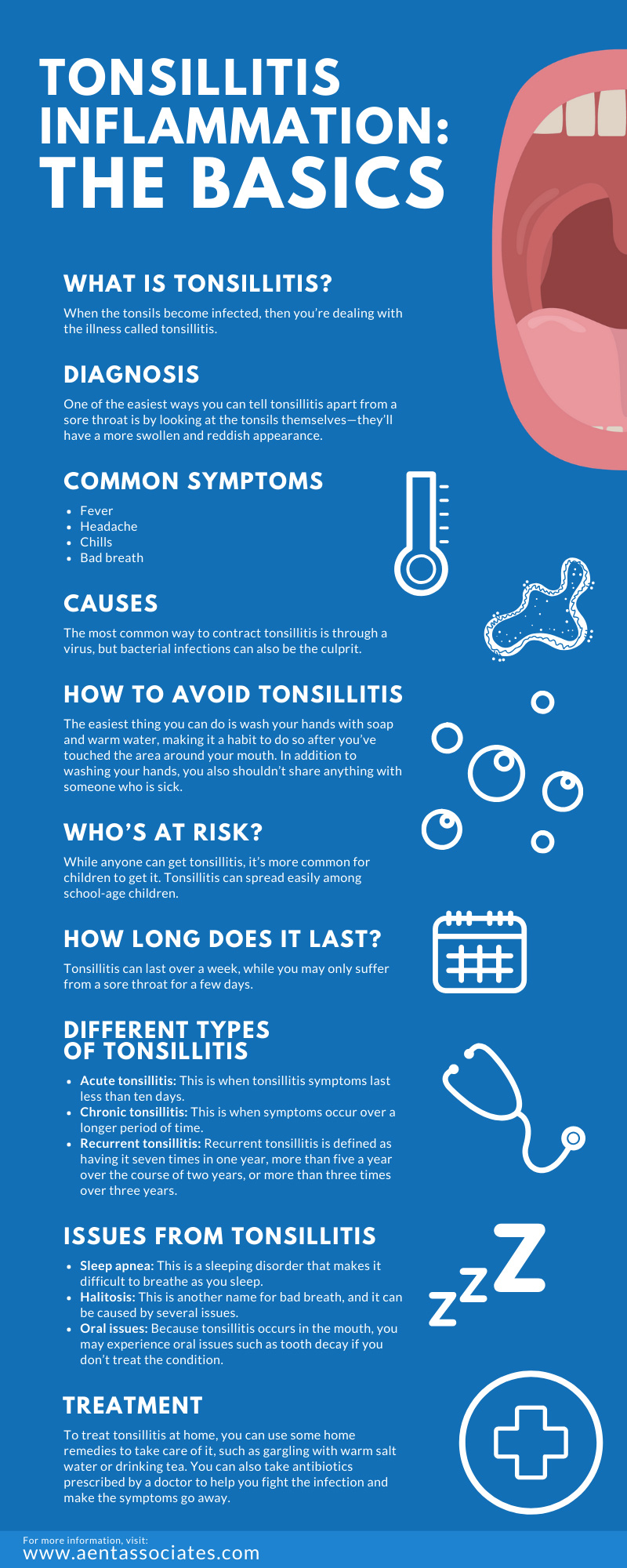Many medical issues can affect your ears, nose, and throat, which is why there are specialists that focus on these issues. One of the most common ENT issues that people suffer from is tonsillitis. Many people may be aware of a sore throat, but they may not always know whether it’s strep throat, tonsillitis, or simply a cold. If you have pain in your throat and tonsil inflammation and want to know the severity of your condition, here are the basics of tonsillitis inflammation.
What is Tonsillitis?
Your tonsils are located in the back of your throat in the form of two lymph nodes. Tonsils are a part of the body’s immune system, and their purpose is to protect your body from getting an infection. However, in some cases, the tonsils themselves can become infected. When the tonsils become infected and inflamed, then you’re dealing with the illness called tonsillitis.
Diagnosis
One of the easiest ways you can tell tonsillitis apart from a sore throat is by looking at the tonsils themselves—they’ll have a more swollen and reddish appearance. This is what a doctor will look for if you decide to go in and visit an ENT. In some cases, your inflamed tonsils may have white or yellow spots on them as well.
Common Symptoms
Besides tonsil inflammation, plenty of other common symptoms are associated with tonsillitis. Perhaps the most common and easiest to identify is a sore throat. If you’re suffering from tonsillitis, you may also have the following symptoms:
- Fever
- Headache
- Chills
- Bad breath
- Earache
- Stiff neck
- Poor appetite
- Drooling
Causes
People commonly get sick due to airborne germs, viruses, and bacteria, which is why the tonsils are there as a line of defense. The most common way to contract tonsillitis is through a virus, but bacterial infections can also be the culprit. Tonsillitis is contagious, so it’s important to keep your distance from those you may have it. If you’re suffering from it yourself, make sure that you stay home from work or school for at least 24 hours as you recover.
How to Avoid Tonsillitis
If you’re worried about getting tonsillitis, you can follow a few methods in order to prevent this medical issue. The easiest thing you can do is wash your hands with soap and warm water, making it a habit to do so after you’ve touched the area around your mouth. In addition to washing your hands, you also shouldn’t share anything with someone who is sick. A final way to avoid tonsillitis is to regularly replace your toothbrush every three months. By taking advantage of these methods, you decrease the risk of obtaining tonsillitis.
Who’s at Risk?
While anyone can get tonsillitis, it’s more common for children to get it. Tonsillitis can spread easily among school-age children. If you’re an adult who experiences frequent throat pain and tonsillitis, there may be a bigger issue at play, and you may require surgery.
How Long Does It Last?
It can be easy to confuse tonsillitis and a common strep or sore throat, but the easy distinction is how long they both last. Tonsillitis can last over a week, while you may only suffer from a sore throat for a few days. If you do notice that you have tonsillitis for a decent amount of time, you should go see the doctor for further treatment.
Different Types of Tonsillitis
You can actually suffer from one of several different types of tonsillitis. The type of tonsillitis you have can play a role in how long you suffer from the sickness and the symptoms you experience.
- Acute tonsillitis: The first type you need to worry about is acute tonsillitis. This is when tonsillitis symptoms last less than ten days. Acute tonsillitis is a less serious type of the illness. Certain treatments may still be necessary, but you can usually cure this type with home remedies and medicine.
- Chronic tonsillitis: This is when symptoms occur over a longer period of time. Because of this, seeing a doctor is completely necessary.
- Recurrent tonsillitis: This is the third and final type of tonsillitis you can suffer from. The main difference between recurrent tonsillitis and the other two types we mentioned above is that this type is a reoccurring issue you have been dealing with. Recurrent tonsillitis is defined as having it seven times in one year, more than five a year over the course of two years, or more than three times over three years.
Issues from Tonsillitis
Tonsillitis isn’t considering an incredibly dire medical condition, but if you’re suffering from it, it still requires your attention due to the issues that can come with it. Some of the most common issues that derive from tonsillitis include:
- Sleep apnea: This is a sleeping disorder that makes it difficult to breathe as you sleep. Sleep apnea is dangerous because it can lead to a heart attack, diabetes, cancer, or other disorders. This is typically identified by loud snoring while you’re sleeping; however, untreated tonsillitis can lead to this issue as well.
- Halitosis: This is another name for bad breath, and it can be caused by several issues. These might include your diet and medical conditions such as postnasal drip, mucus buildup, and, of course, tonsillitis.
- Oral issues: Because tonsillitis occurs in the mouth, you may experience oral issues such as tooth decay if you don’t treat the condition.
Treatment
It’s never a bad idea to visit a doctor if you’re experiencing pain, especially if symptoms are persistent. To treat tonsillitis at home, you can take use some home remedies to take care of it, such as gargling with warm salt water or drinking tea. You can also take antibiotics prescribed by a doctor to help you fight the infection and make the symptoms go away. There’s also chance you might have to have your tonsils removed, which is a procedure called a tonsillectomy. This will happen if you suffer from recurrent tonsillitis.
If you think you may be suffering from tonsillitis, make sure to pay our Cypress ENT office a visit. We can take care of all your asthma, allergy, and ENT needs.



